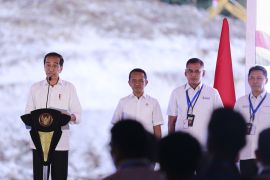Vice Director of Pupuk Indonesia Nugroho Christijanto highlighted that the first step was to join forces with several tech-owned entities. To this end, Pupuk Indonesia has initiated cooperation with two companies: TOYO Engineering Corporation and Mitsui & Co Ltd.
"We have reached a cooperation agreement with TOYO and Mitsui. The cooperation is mutual, as they own the technologies required while we have the facilities," Nugroho noted in his statement in Jakarta on Monday.
Under the second step, the state-owned company will collaborate with industry actors in order to address common needs by exchanging the products required by each.
"We will offer them our products in exchange for theirs. Hence, we will be able to comply with the decarbonization target at the same time," he affirmed.
The third step is the need for a broader inter-ecosystem collaboration in the form of cross-sector cooperation, such as between maritime and energy companies.
"The final step is to establish an inter-ecosystem collaboration in a much broader term. I am convinced that we cannot deny that ammonia someday will be an energy resource in addition to being utilized in the way we now know. It might even be utilized in the maritime industry," Nugroho remarked.
These three steps are expected to help promote the utilization of ammonia in various fields that in turn will help the government to reduce greenhouse gas emissions. The net-zero emission target is expected to ultimately be achieved by the year 2060.
"We are attempting to decarbonize what we have from our ammonia factories, our power plants, and other facilities that are producing greenhouse gas emissions," Nugroho stated.
Meanwhile, Executive Officer/Division Director of Solution Business Toyo Engineering Corp Eiji Sakata affirmed that his company was all set and geared up to assist Pupuk Indonesia and the government to reduce emissions.
To this end, TOYO has decided to cooperate with Pupuk Indonesia in constructing factories to produce ammonia in Indonesia.
"We have a big interest in ammonia, and we see a great opportunity to engage in its production, especially green and blue types of ammonia," Sakata remarked.
Managing Executive Officer of IHI Corporation Nobuhiko Kubota affirmed that his company was committed to partaking in resolving problems related to greenhouse gas emissions. Hence, IHI has prepared a thorough ammonia supply chain, from upstream to downstream.
Despite technological obstacles, IHI will consistently produce green ammonia. As for the downstream, IHI has also figured out the usage.
"In the downstream, ammonia will be fed to a 2-MW (class) gas turbine. As for maritime, we are currently working to establish a designated industry, and recently, we have been using ammonia in the steel forging industry and so on," Kubota stated.
Concurrently, Business Development Director Southeast Asia & Australia KBR Inc Roy Daroyni remarked that ammonia could be used as a solution to reducing greenhouse gas emissions. That is being said by referring to the fact that ammonia is extremely useful as an energy resource, including for transportation.
"Thus, the leverage of using ammonia as fuel is that it can help reduce carbon emissions, and we can continue using the existing assets. Hence, we are striving to achieve the decarbonization target by utilizing clean ammonia," Daroyni remarked.
Related news: Pupuk Indonesia aims for Indonesia to become world's ammonia hub
Related news: Ministry asks Pupuk Indonesia to develop ammonia ecosystem
Translator: Tegar Nurfitra
Editor: Rahmad Nasution
Copyright © ANTARA 2023












